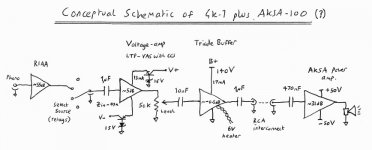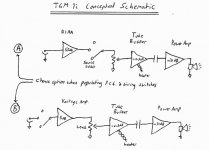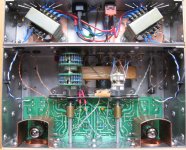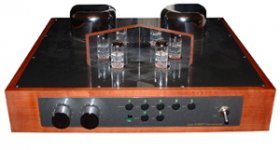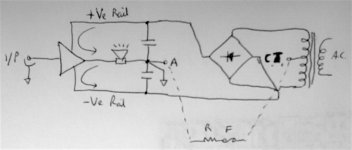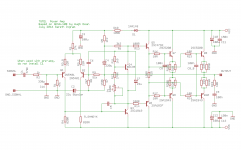Member
Joined 2009
Paid Member
I’m going to re-do my first DIY audio project ( TGM Amplifier ? ) from the ground up, as an integrated amplifier, based on the AKSA-100W and a few ideas from the GK-1 tube pre-amplifier. Amazing things were written about both of these products, they created a very special feeling for those who were lucky to have them and although his new designs far surpass the original there remains for me an attraction to what I consider to be a Classic. I want to make a keep-sake version that is better built than my first effort. I’m not sure if I’ll be able to achieve all my goals yet:
> dual mono power supply (strongly recommended by Hugh) -
> shunt-regulated 6DJ8/ECC88 cathode follower pre-amp (inspired by GK-1) - T.B.D.
> optional RIAA inspired by the early British NAD 3020 (I’ve no idea what Hugh used, this is my choice)
> through-hole parts construction (I don’t believe Hugh used SMD until after AKSA) -
> should be able to use parts easily available (heck, the tube is still in production !)
This thread will be a kind of blog, it won’t be fast moving, especially in mid-summer, but feel free to jump in with questions and to share your thoughts.
Some interesting reading here:http://www.aesmelbourne.org.au/wp-content/media/THE AKSA STORY.pdf
And a sanctioned clone of the AKSA-55 can be found here: Based on Hugh Dean's AKSA 55
EDIT 4 Nov 2017: well I just couldn't stuff the power amp, the power supply and the pre-amplifier all into the box I had on hand. So it's going to be a dis-integrated amplifier 😀
The power-amp is done, I may tweak some parts later once I get into more extensive listening tests
The power supply is here:TGM - an external PSU for power-amp
The pre-amp is here:TGMC - a modular control pre-amplifier
> dual mono power supply (strongly recommended by Hugh) -

> shunt-regulated 6DJ8/ECC88 cathode follower pre-amp (inspired by GK-1) - T.B.D.
> optional RIAA inspired by the early British NAD 3020 (I’ve no idea what Hugh used, this is my choice)
> through-hole parts construction (I don’t believe Hugh used SMD until after AKSA) -

> should be able to use parts easily available (heck, the tube is still in production !)
This thread will be a kind of blog, it won’t be fast moving, especially in mid-summer, but feel free to jump in with questions and to share your thoughts.
Some interesting reading here:http://www.aesmelbourne.org.au/wp-content/media/THE AKSA STORY.pdf
And a sanctioned clone of the AKSA-55 can be found here: Based on Hugh Dean's AKSA 55
EDIT 4 Nov 2017: well I just couldn't stuff the power amp, the power supply and the pre-amplifier all into the box I had on hand. So it's going to be a dis-integrated amplifier 😀
The power-amp is done, I may tweak some parts later once I get into more extensive listening tests
The power supply is here:TGM - an external PSU for power-amp
The pre-amp is here:TGMC - a modular control pre-amplifier
Last edited:
Member
Joined 2009
Paid Member
There's a quite a lot to consider, the GK-1 is not in the public domain and I won't attempt to reverse-engineer it here. But from what has been published I can draw an overview of what a GK-1 and AKSA-100 might look like - a bit of a guess on my part.
There's too much here for me to include in this project but I think it can be simplified without losing the essence of it. First off, I don't need voltage gain from the pre-amp for my music sources but I do want the RIAA and the anti-phase shunt regulated tube buffer thingy. And for anybody following along who didn't want the RIAA they could wire it up as a 5dB voltage amp instead.
The power amp should be carefully considered even though we have a fairly good idea what that looks like. I'll take the baby AKSA concept / TGM1 power amp and add a second pair of output transistors, but the devil will be in the details.
There's too much here for me to include in this project but I think it can be simplified without losing the essence of it. First off, I don't need voltage gain from the pre-amp for my music sources but I do want the RIAA and the anti-phase shunt regulated tube buffer thingy. And for anybody following along who didn't want the RIAA they could wire it up as a 5dB voltage amp instead.
The power amp should be carefully considered even though we have a fairly good idea what that looks like. I'll take the baby AKSA concept / TGM1 power amp and add a second pair of output transistors, but the devil will be in the details.
Attachments
Last edited:
Member
Joined 2009
Paid Member
Member
Joined 2009
Paid Member
Here's a nice photo of one chaps GK-1 (underside) and a photo of a professional version. Isn't it a beauty ! - that's a lot more preamp than I will try tackle here though but I will get a taste of it, something to be inspired by for this project 

Attachments
Last edited:
Member
Joined 2009
Paid Member
It's going to be difficult to put all this on one pcb, even as dual mono. And my experience is all with Eagle layout software in which the freeware version is limited to 100mm x 80mm.
So, darn it, I'm thinking this project had better go on two different pcb's and I"m not sure the best way to split this up but it seems traditional to go with:
one) Power amp + main rectifier & filter caps, one channel per board
two) Pre-amp + regulators, stereo board
Sometimes the old 'one - two' is the best approach to the goal
So, darn it, I'm thinking this project had better go on two different pcb's and I"m not sure the best way to split this up but it seems traditional to go with:
one) Power amp + main rectifier & filter caps, one channel per board
two) Pre-amp + regulators, stereo board
Sometimes the old 'one - two' is the best approach to the goal

Attachments
Have you considered output DC protection in board one, too?
Board one also can be used alone, dual mono.
Board one also can be used alone, dual mono.
Last edited:
Member
Joined 2009
Paid Member
I could readily include it, but there are some trade-offs to decice.
The last time I included dc-protection I used surface mount parts (and there was a large groan from some members of the audience) - I used 1206 resistors that are relatively easy to use, nothing smaller and I kept all the 3-legged transistors as through-hole parts. The dc protection was implemented with a solid state relay using a surface mount photo-voltaic isolating chip to drive the gates of the two FETs forming the solid state relay. This isolating chip is only available as a surface mount part. I can understand the reticence from some folk to use surface mount parts or the use of specialized components, a through-hole solution using commonly available parts is appealing.
There are some all-in-one solid state relays available now that weren't around when I did that project and which don't need surface mount parts but they aren't available at the corner store (see attached datasheet) so there is a risk that the amplifier will not be repairable or unable to be assembled in a few years from now. It's an appealing option though isn't it.
A mechanical relay would likely be more universal but I'd have to find enough space on the pcb to do this and Hugh was always against the use of mechanical relay contacts in the output signal.
The last time I included dc-protection I used surface mount parts (and there was a large groan from some members of the audience) - I used 1206 resistors that are relatively easy to use, nothing smaller and I kept all the 3-legged transistors as through-hole parts. The dc protection was implemented with a solid state relay using a surface mount photo-voltaic isolating chip to drive the gates of the two FETs forming the solid state relay. This isolating chip is only available as a surface mount part. I can understand the reticence from some folk to use surface mount parts or the use of specialized components, a through-hole solution using commonly available parts is appealing.
There are some all-in-one solid state relays available now that weren't around when I did that project and which don't need surface mount parts but they aren't available at the corner store (see attached datasheet) so there is a risk that the amplifier will not be repairable or unable to be assembled in a few years from now. It's an appealing option though isn't it.
A mechanical relay would likely be more universal but I'd have to find enough space on the pcb to do this and Hugh was always against the use of mechanical relay contacts in the output signal.
Attachments
Last edited:
Member
Joined 2009
Paid Member
If we go with dual-mono supply there's another way to look at this, an approach I took with my TGM7 (mono) amplifier.
See the drawing I attached - the only way that dc current can flow through the speaker is if point 'A' is attached to the centre-tap of the transformer 'C.T.' since current must flow in a loop.
By placing a limiting resistance between point 'A' and 'C.T.' it's possible to limit the current that can flow. In normal use, the power supply rail capacitors (shown) are the return path for the a.c. signals flowing through the speaker and no current should flow to the centre-tap of the transformer. Of course, there is some frequency, a low frequency, at which the rail capacitors become a higher impedance than the connection to the centre-tap of the transformer and current will flow that way - all this means is making sure the rail capacitors are large enough.
This approach would keep d.c. out of the speaker. In a stereo set-up both channels must have their own supply, or at least separate windings on the power transformer.
And this approach would not prevent start up or power down noises from the signal chain or amplifier affecting enjoyment so a means to mute the sound may be useful ( a shut relay from VAS to ground would probably suffice and it would not place any relay contacts in the signal path ).
Any recommendations as to best set of trade-offs ? (I'm not that concerned that a mechanical relay at the output will somehow spoil the sound but I wait to be corrected...)
See the drawing I attached - the only way that dc current can flow through the speaker is if point 'A' is attached to the centre-tap of the transformer 'C.T.' since current must flow in a loop.
By placing a limiting resistance between point 'A' and 'C.T.' it's possible to limit the current that can flow. In normal use, the power supply rail capacitors (shown) are the return path for the a.c. signals flowing through the speaker and no current should flow to the centre-tap of the transformer. Of course, there is some frequency, a low frequency, at which the rail capacitors become a higher impedance than the connection to the centre-tap of the transformer and current will flow that way - all this means is making sure the rail capacitors are large enough.
This approach would keep d.c. out of the speaker. In a stereo set-up both channels must have their own supply, or at least separate windings on the power transformer.
And this approach would not prevent start up or power down noises from the signal chain or amplifier affecting enjoyment so a means to mute the sound may be useful ( a shut relay from VAS to ground would probably suffice and it would not place any relay contacts in the signal path ).
Any recommendations as to best set of trade-offs ? (I'm not that concerned that a mechanical relay at the output will somehow spoil the sound but I wait to be corrected...)
Attachments
Just for my education: Can one shift the ground connection shown to the other side of the LS ?
Pl see http://www.diyaudio.com/forums/solid-state/170837-140v-single-rail-nmos-amp-5.html#post2270892 for a similar idea for LS connection.
Pl see http://www.diyaudio.com/forums/solid-state/170837-140v-single-rail-nmos-amp-5.html#post2270892 for a similar idea for LS connection.
Attachments
Member
Joined 2009
Paid Member
Yes, you can place ground anywhere you like more or less (in the example shown you will have your speaker connections at a dc voltage so care would be needed not to short the wires to the chasis or some other grounded object). But note that the RCA cable coming to your amplifier likely has the outer shield/return at ground potential.
I'm leaning towards adding dc speaker protection in order to provide a mute function so that we don't have to worry about turn-on and turn-off noises, including the warm-up of the pre-amp vacuum tube.
I'm leaning towards adding dc speaker protection in order to provide a mute function so that we don't have to worry about turn-on and turn-off noises, including the warm-up of the pre-amp vacuum tube.
Here's a nice photo of one chaps GK-1 (underside) and a photo of a professional version. Isn't it a beauty ! - that's a lot more preamp than I will try tackle here though but I will get a taste of it, something to be inspired by for this project
Interesting Gizmo certainly.
Does seem like The antithesis of KISS tho.
Member
Joined 2009
Paid Member
Better get a schematic up here before I get bored 😛
This is what I think the AKSA-100 is close to, based on the links I gave in the first post and some reading I've done on the internet at this and other forums where the AKSA details have been given some public airing.
The feedback network is much closer to what AKSA uses than I had in my first TGM amplifier. I don't know what values Hugh used, so unless he releases those I am making a stab at something which is probably close enough. The concept of the feedback network is to separate a bit more the ac and dc signal paths. The benefit was never clear to me but this link has at least one explanation for it: Power Amplifier Clipping
I haven't used a ground-lift resistor in my own designs for many years so I've dropped it from this version (Hugh labels this resistor R2) and instead I have incorporated an RC filter to reduce r.f. ingress at the amplifier input. I've included an input coupling capacitor but I have no plans to use such a thing when I built it into a chassis with a pre-amp that already has a coupling capacitor on it's output.
I have also included LTP degeneration resistors, this was part of an upgrade to AKSA. I've used 22R for now.
I have also included a resistor in the 'unused' leg of the LTP. This was proposed by a forum member SandyK many years ago and was derived from listening tests. It is NOT about trying to balance current in the LTP legs, it is about equalizing the voltage at the collectors to balance the Early Effect. I have no idea if this is a worthwhile addition but I show it to generate some debate.
I may have the gain set too high. I suspect that the LTP current and the value of R4 is different from the baseline AKSA-100 too and maybe worth some debate - and guidance from Hugh.
This is what I think the AKSA-100 is close to, based on the links I gave in the first post and some reading I've done on the internet at this and other forums where the AKSA details have been given some public airing.
The feedback network is much closer to what AKSA uses than I had in my first TGM amplifier. I don't know what values Hugh used, so unless he releases those I am making a stab at something which is probably close enough. The concept of the feedback network is to separate a bit more the ac and dc signal paths. The benefit was never clear to me but this link has at least one explanation for it: Power Amplifier Clipping
I haven't used a ground-lift resistor in my own designs for many years so I've dropped it from this version (Hugh labels this resistor R2) and instead I have incorporated an RC filter to reduce r.f. ingress at the amplifier input. I've included an input coupling capacitor but I have no plans to use such a thing when I built it into a chassis with a pre-amp that already has a coupling capacitor on it's output.
I have also included LTP degeneration resistors, this was part of an upgrade to AKSA. I've used 22R for now.
I have also included a resistor in the 'unused' leg of the LTP. This was proposed by a forum member SandyK many years ago and was derived from listening tests. It is NOT about trying to balance current in the LTP legs, it is about equalizing the voltage at the collectors to balance the Early Effect. I have no idea if this is a worthwhile addition but I show it to generate some debate.
I may have the gain set too high. I suspect that the LTP current and the value of R4 is different from the baseline AKSA-100 too and maybe worth some debate - and guidance from Hugh.
Attachments
Last edited:
Hi Bigun
I'm not sure that AKSA ever offered speaker protection as an option for the kit, so if you're trying to stay true to the original formula then that's a consideration.
I just don't see the point of using a mechanical relay to protect against DC when nowadays we are spoilt for choice with rugged Power FETs that have extremely low Rds(on), unless (a) it is being used in the speaker line and (b) we are paranoid about FET distortion and want to use some high quality "audiophile" grade relay as an alternative.
I really like the protect circuit you designed into TGM8, but nowadays I use Power FETs inserted in the main rails to cut power to the outputs in the event of a problem.
In terms of the AKSA circuit, it has always bothered me (probably for aesthetic reasons only) that the RC filter is on the +ve rail where the current sources are arranged, when in actual fact it would do more good on the -ve rail wedged between the driver and VAS transistor, assuming of course that the LTP tail had a proper current source. But Hugh designed this to sound good (and by all reports it sounds exceptionally good...) and not necessarily win awards in the laboratory measurement stakes... I guess the P3A better appeals to my aesthetic tastes, but I sure would like to build an AKSA some day.
I'm not sure that AKSA ever offered speaker protection as an option for the kit, so if you're trying to stay true to the original formula then that's a consideration.
I just don't see the point of using a mechanical relay to protect against DC when nowadays we are spoilt for choice with rugged Power FETs that have extremely low Rds(on), unless (a) it is being used in the speaker line and (b) we are paranoid about FET distortion and want to use some high quality "audiophile" grade relay as an alternative.
I really like the protect circuit you designed into TGM8, but nowadays I use Power FETs inserted in the main rails to cut power to the outputs in the event of a problem.
In terms of the AKSA circuit, it has always bothered me (probably for aesthetic reasons only) that the RC filter is on the +ve rail where the current sources are arranged, when in actual fact it would do more good on the -ve rail wedged between the driver and VAS transistor, assuming of course that the LTP tail had a proper current source. But Hugh designed this to sound good (and by all reports it sounds exceptionally good...) and not necessarily win awards in the laboratory measurement stakes... I guess the P3A better appeals to my aesthetic tastes, but I sure would like to build an AKSA some day.
Here is a nice DC protect circuit with FET switch and opto-isolator.
http://www.diyaudio.com/forums/atta...ce-schematic-dc-detect-3.2-revised-values.pdf
From here:
http://www.diyaudio.com/forums/solid-state/264313-how-build-21-st-century-protection-board-132.html
http://www.diyaudio.com/forums/atta...ce-schematic-dc-detect-3.2-revised-values.pdf
From here:
http://www.diyaudio.com/forums/solid-state/264313-how-build-21-st-century-protection-board-132.html
- Status
- Not open for further replies.
- Home
- Amplifiers
- Solid State
- TGM 1i - an integrated hybrid amp inspired by Hugh Dean
